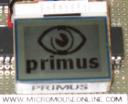Decimus hardware fix
It was all getting too awkward. A bit of short sighted design on my part had the Nokia LCD sharing an SPI port with the motor encoders. This meant that I had to turn off the encoders to write to the LCD. While no motion information would be lost by doing this, it effectively meant that I could not, for example, have the mouse hold position while updating the display. In the end I took it all apart and patched the circuit board so that the LCD is now driven from the SPI1 port and the encoders are on the SPI2 port.
